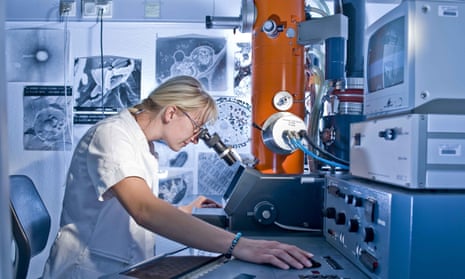In early March, the internet was introduced to the best-case scenario for what happens when women are the butt of online abuse: Emily Temple-Wood.
Since she was 12 years old, The 24-year-old Loyola University of Chicago biology student has contributed hundreds of biographies of prominent women in science to Wikipedia, in the name of improving its coverage of female scientists. With her mission came exposure, and with exposure, a hail of lewd and misogynist emails that objected to her work.
But in the past two weeks, she’s become known for something else: converting her anger at each nasty comment she receives into one new Wikipedia entry for a forgotten pioneer. Among her hundreds of entries are Ann Bishop, the parasitologist whose second world war-era work was key to understanding malaria, and Rosalyn Scott, a pioneering black surgeon.
“As a woman on the internet, I get a lot of harassment,” she said in a recent interview. “I was getting fed up with having so much rage directed at a faceless someone.” Adding a new biography for each crude email, she reasoned, was a better channel for her anger.
But in addition to swelling the ranks of women scientists in Wikipedia’s vast catalogues, Temple-Wood’s mission is raising another question: why was there such an imbalance in the first place?

It’s a problem that has dogged Wikipedia contributors for years, and is a big factor in why, a year ago, only 15% of all the site’s biographical entries were written about women.
Statistics provide part of the answer: there just aren’t as many women in science. Only 24% of workers in the Stem fields are women, according to a recent census estimate. There other issue, she says, is a sore lack of information. Even finding historical information about women in science is a challenge.
“There is just not a lot of information on women in science that is readily accessible to the average Wikipedia editor,” she says. “And that’s because of the way that women’s contributions to the sciences have been brushed under the rug for centuries.”
Rosie Stephenson-Goodknight, another editor who runs a Wikipedia project aimed at boosting that number, said the same research challenge tends to apply across all professions and cultures.
Open any historical work or biography, she says, and “it will have five paragraphs for every man and only one paragraph about the woman doing the same work … I can’t imagine that’s because the men’s work was twice as good as the women’s.”
What’s more likely, she says, is that the male biographers were uninterested in the contributions of women. And as their knowledge – compiled in encyclopedias and anthologies – migrated online, so did their embedded biases.
As a result, compiling information about a woman to include in a Wikipedia entry often requires an effort to piece together her biography from many scattered sources. Whereas most Wikipedia contributors can source at least parts of their articles from the web, Temple-Wood said her work often calls for her to trawl rare journals or library basements.
Wikipedia is aware of the imbalance, and it has undertaken projects to increase the number of articles about women and women contributors, who currently make up less than a quarter of the site’s writers. For instance, it has sponsored editathons focused on adding more entries about Asian and Pacific Islander American women, and Wikipedia regularly hosts meet-ups to recruit new female editors.
But challenges inside the contributor community persist. For example, in efforts to clean up the site by nominating entries for deletion, Stephenson-Goodknight says she often notices that thinly sourced articles about women get singled out for deletion when the same articles could easily be expanded and substantiated.
In 2015, Roger Bamkin, a Wikipedia editor and former board member, proposed a focused initiative titled “How to pick up more women”. Stephenson-Goodnight signed on, and after a pointed reconsideration of the name, the campaign became the WikiProject Women in Red.
Women in Red collectively adds an average of 1,500 new entries about women or their work every month. Thanks to the group, 16% of biographies on English-language Wikipedia are now written about women, up from 15%.
Temple-Wood’s mission to expand the ranks of women scientists on Wikipedia is just a sliver of their challenge. But historians say that the way women who make important contributions to science are remembered – or not – is a case study in why so many women are missing from Wikipedia in the first place.
“Historically, we’ve defined science as happening only in very particular realms that women were systematically excluded from,” said Margaret O’Mara, a historian at the University of Washington. “If it wasn’t happening in the lab, it wasn’t science – it was feminine work.”
O’Mara cites the example of the women recruited to operate early computers. Men built the computer, which was considered to be the true intellectual challenge, while the women inputting 1s and 0s were regarded as clerical workers. But today, those women would be recognized as something else entirely: coders.
In many cases where women did work in the lab, they have been forgotten, says Margaret Rossiter, a Cornell University science historian. “They were always there,” she says. “But they got marginalized and made invisible:‘She was only doing the grunt work, she was only the co-author, she did the work but she didn’t think of the work,’ all these comments minimize their contributions.”
That’s how a naturalist who was never paid for her work came to be remembered as a hobbyist, or why midwives fail to be remembered.
“I accept that if we look at people who are considered notable, and have enough of a historical record about them, we’re not going to have an equal number of potential articles about women,” said Stephenson-Goodknight.
“But we know there’s information about women out there. We just need people who are committed to seeking out that information.”

Comments (…)
Sign in or create your Guardian account to join the discussion